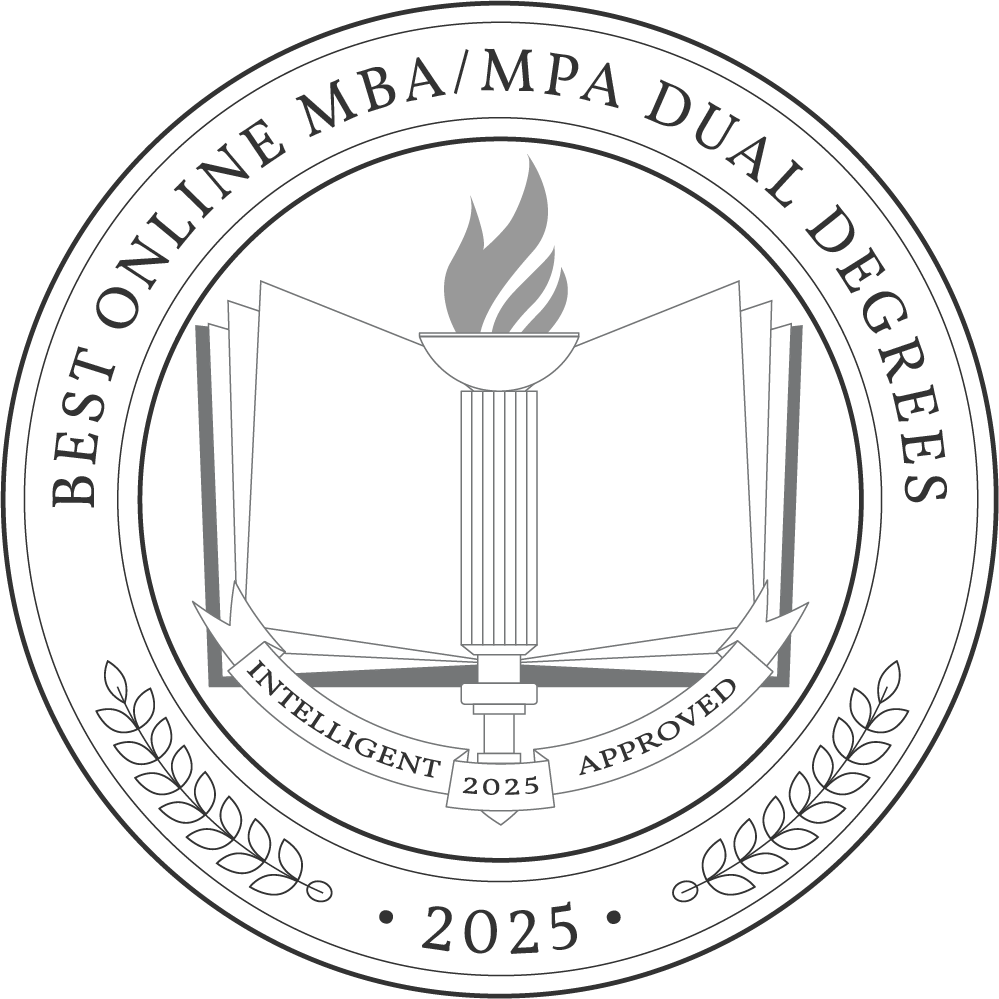In today’s dynamic professional landscape, the demand for versatile leaders equipped with both business acumen and public administration expertise is on the rise. Online MBA/MPA dual degree programs offer a comprehensive curriculum designed to prepare students for leadership roles in government, nonprofit organizations, and the private sector.
Graduates of these programs are well-positioned for diverse roles such as public policy analyst, government relations manager, or nonprofit executive, with average salaries ranging from $80,000 to more than $120,000 per year, according to the U.S. Bureau of Labor Statistics. Typically spanning two to three years of full-time study, online dual degree programs offer flexibility for working professionals to balance their academic pursuits with professional and personal commitments.
The cost of completing a master’s degree program varies widely, but data from the National Center for Education Statistics indicates an average cost for masters-level programs that ranges from about $12,500 to $30,000.
Why Trust Us
The Intelligent.com Higher Education Team is dedicated to providing students with independent, equitable school and program rankings and well-researched resources. Our expert-driven articles cover topics related to online colleges and programs, paying for school, and career outlooks. We use data from the U.S. Department of Education’s College Scorecard, the National Center for Education Statistics, and other reputable educational and professional organizations. Our academic advisory team reviews content and verifies accuracy throughout the year for the most current information. Partnerships do not influence rankings or editorial decisions.
- Analyzed over 2,000 national, accredited, and nonprofit colleges and universities
- 800+ rankings pages are reviewed and updated yearly
- Content is informed by reputable sources, surveys, and interviews with academic advisors and other experts
- Over 100 data points are reviewed for accuracy and quality throughout the year, including sources
How we rank schools
Our list features the best online MBA/MPA Dual degree programs at top colleges nationwide. Each school featured is a nonprofit, accredited institution — either public or private — with a high standard of academic quality for post-secondary institutions.
We evaluated each school’s program on tuition costs, admission, retention and graduation rates, faculty, reputation, and the student resources provided for online students. We collected data from trusted sources like the National Center for Education Statistics, individual school and program websites, school admissions counselors, and other data sources. Then, we calculated the Intelligent Score on a scale of 0 to 100 based on the following criterion:
Academic Quality:
- Admission rate versus enrollment rate
- Retention rate of students who return after year one
- Accreditation status (regional and programmatic)
- Nonprofit status, both private and public institutions
Graduation Rate
- Overall graduation rate
- Total number of currently enrolled students, including diversity metrics
- Student-to-faculty ratio
Cost and ROI
- In-state and out-of-state per-credit tuition rates and fees
- Required credits to graduate
- Earning potential after graduation
- Availability of federal student loans, scholarships, and other financial aid options
Student Resources
- Available student services for online-only and hybrid programs
- On-campus amenities like tutoring centers and the number of libraries
Read more about our ranking methodology.
Best 2 Online MBA/MPA Dual Degree Programs
FiltersInstitution Type
Status
- Intelligent Score
- Alphabetically By University Name
- Acceptance Rate
- Enrollment
- In-state Graduate Tuition
- Out-of-state Graduate Tuition
- In-state Undergraduate Tuition
- Out-of-state Undergraduate Tuition

Hamline University
Intelligent Score: 98.49In-state: $43,154
Out-of-state: $43,154
In-state: $11,570
Out-of-state: $11,570
SAT: 995-1225
ACT: 20-26
$792
Online, On-Campus
Higher Learning Commission
72

Appalachian State University
Intelligent Score: 96.57In-state: $4,242
Out-of-state: $19,049
In-state: $4,839
Out-of-state: $4,839
SAT: 1070-1240
ACT: 22-27
$544
Online, On-Campus
Association to Advance Collegiate Schools of Business
60
How to Choose an Online MBA/MPA Dual Degree Program
Choose your area of study
When selecting your area of study, consider your career aspirations and personal interests. Research various specializations, such as public administration, healthcare management, or environmental policy to determine which aligns best with your goals. Evaluate the curriculum of each specialization, including course offerings and practical experiences like internships or capstone projects. Explore job market trends and salary potential for each field to ensure it aligns with your professional objectives. Consider seeking guidance from academic advisors or professionals in your desired industry to gain insights and make an informed decision.
Research schools and programs
Compile a list of accredited institutions offering your desired dual degree. Evaluate factors such as program reputation, faculty expertise, and curriculum relevance to your career goals. Look into program delivery methods, including asynchronous or synchronous formats, to ensure compatibility with your schedule. When comparing programs, consider factors like tuition costs, financial aid options, and student support services. Explore alumni outcomes and student reviews to gauge program satisfaction and post-graduation success.
Prepare for tests and applications
Familiarize yourself with program-specific admission requirements for your potential program, which may include standardized tests like the GRE or GMAT. Allocate sufficient time to study for these exams and consider enrolling in test preparation courses if needed. Gather all necessary application materials, such as transcripts, letters of recommendation, and personal statements, and ensure they are completed accurately and submitted on time. Polish your resume to highlight relevant skills and experiences, and consider seeking guidance from mentors or admissions advisors during the application process to maximize your chances of acceptance.
Select your program
Research accredited institutions offering your desired program. Evaluate factors such as program reputation, faculty expertise, and curriculum relevance to your career goals. Consider the program’s format and flexibility to ensure it fits your schedule and learning preferences. Look into opportunities for networking and internships to enhance your professional development. Compare tuition costs, financial aid options, and alumni outcomes so you can make an informed decision.
Determine how you’ll pay for your degree
Research financial aid options such as scholarships, grants, and student loans offered by the institution or external organizations. Complete the Free Application for Federal Student Aid (FAFSA) to determine eligibility for federal aid programs. Explore employer tuition reimbursement programs or employer-sponsored scholarships if you are currently working. Calculate the total cost of attendance, including tuition, fees, and living expenses, to develop a realistic budget. You may want to develop a long-term financial plan to manage debt and minimize financial stress as you undertake your academic journey.
What Can You Expect From an Online MBA/MPA Dual Degree Program?
An online MBA/MPA program offers a comprehensive curriculum designed to equip students with advanced skills in both business administration and public administration. Expect to learn core concepts in management, finance, economics, public policy, and organizational leadership. Students will develop analytical and strategic thinking skills crucial for leadership roles in both the private and public sectors. Typically, these programs take about two to three years to complete, depending on whether you enroll full- or part-time.
Courses are usually delivered through an online platform, providing flexibility for working professionals. However, some programs may require occasional in-person components, such as residencies, workshops, or on-campus labs, to allow for hands-on learning and networking opportunities. In some programs, students may need to complete a capstone project or internship to gain practical experience.
Overall, an online MBA/MPA dual degree program prepares graduates for diverse and high-level roles, offering the flexibility to balance studies with personal and professional commitments.
Potential courses you’ll take in an online MBA/MPA dual degree program
- Organizational Behavior and Leadership. Explores the dynamics of individual and group behavior within organizations. Students learn about leadership theories, motivation, team dynamics, and conflict resolution, equipping them with skills to effectively lead and manage diverse teams.
- Public Policy Analysis. Examines the processes of policy formulation, implementation, and evaluation. Students learn to analyze public policies, assess their impact, and propose improvements, preparing them for roles in government and nonprofit sectors.
- Financial Management. Covers principles of financial planning, analysis, and control in both public and private sectors. Students gain expertise in budgeting, financial reporting, and investment strategies.
- Strategic Management. Explores the formulation and implementation of business strategies to achieve organizational goals. The course may emphasize competitive analysis, strategic planning, and decision-making processes.
- Ethics in Public Administration. Focuses on the ethical challenges and considerations in public service. Students explore ethical theories and frameworks, learning to apply ethical decision-making in various public administration contexts.
Online MBA/MPA Dual Degree Program Frequently Asked Questions
How do I apply to an online MBA/MPA dual degree program?
Start by completing the application form on the institution’s website. Prepare and submit necessary documents such as transcripts from previous academic institutions, standardized test scores (GRE or GMAT if required), letters of recommendation, and a personal statement outlining your goals and qualifications. Some programs may also require a resume and proof of professional experience. Consider talking to an admissions counselor before applying to clarify any specific requirements or deadlines and gain insights on how to strengthen your application.
How much does an online MBA/MPA dual degree cost?
According to the National Center for Education Statistics, the cost of an online MBA/MPA dual degree program varies widely, typically from $12,500 to $30,000. Additional costs include technology fees, textbooks, and potentially higher fees for out-of-state students at some institutions. Online programs may save on commuting and accommodation expenses compared to in-person programs, but some require occasional in-person residencies or workshops, which could incur travel costs. For detailed cost information, refer to your chosen college or university’s website.
How long does it take to earn an online MBA/MPA dual degree?
Completing an online MBA/MPA dual degree program typically takes about two to three years of full-time study and generally includes anywhere between 60 and 75 credits. Online programs often offer greater flexibility, allowing students to balance coursework with personal and professional commitments. This flexibility can enable part-time students to extend their studies to four years or more, depending on their pace. In contrast, on-campus programs may have more rigid schedules, potentially leading to quicker completion for full-time students but less adaptability for part-time learners. The total number of required credits and individual course load significantly influence the program duration.

